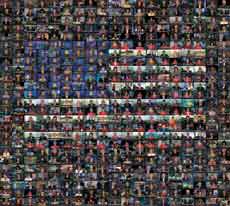
Today I’m uncovering ancient history, a trip July 8 to the Milwaukee Art Museum to see “Cut:Film as found Object.” I always liked the title of the show, partly because — intentionally or not — it refers to the video and filmmaker’s software tool for editing, Final Cut Pro. And for an exhibit that’s all about film and video editing, that reference is perfect.
Another word for the editing that goes on in this exhibit is sampling, and here, like with music, the artists are sampling from extant works and re-mixing them into something new. Many times the mix takes the original source material into strange dark waters never envisioned by the originator. But that’s great, because that’s what art does, it makes a boat from a tree and you the viewer either go with it or you don’t. And the original source — whether it’s that tree, or a flower in your backyard or, as in this show, clips from Hollywood films, CNN news programs, pornography — is just raw material. (top image is Omer Fast‘s “CNN Concatenated,” 2002, 18 minutes, Edition of 5. The piece excerpts snarky cutaway comments by news anchors saying things like “God you make me sick.” I kid you not — that must have been on Crossfire — and “Don’t blame this on your parents.”)
“Cut” has 14 works by an all-star cast of 8 artists — Candice Breitz, Omer Fast, Douglas Gordon, Michael Joaquin Grey, Pierre Huyghe, Christian Marclay, Jennifer and Kevin McCoy and Paul Pfeiffer.
As with all video art exhibits installed in large gallery spaces which have not been sliced up into individual screening rooms, there was audio bleed between a few of the works. Mostly it wasn’t too bad or cacophonous. And actually MAM has made screening rooms with benches for several of the best pieces giving them the equivalent of the star treatment. And that’s a very good thing.
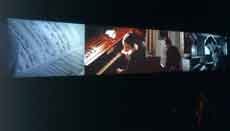
My Oscar for best video goes to Christian Marclay for his “Video Quartet,” 2002, a piece commissioned by the San Francisco MoMA and the Musee d’Art
Moderne Grand-Duc Jean, Luxembourg, “Quartet” samples musical moments from Hollywood movies and because Marclay’s definition of music is broad, what’s shown and heard is not only string interludes and piano arpeggios and harp solos but other percussive sounds like doors slamming, wind howling, foots stomping, hand-clapping, whistling, singing and more. The sounds and images intermix in projections across 4 screens and become a new composition like nothing you’ve seen or heard before. The piece, an 8 x 40 ft. installation, is monumental public art.
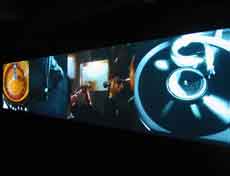
Marclay’s got a good eye for mixing this with that. He doesn’t give you too much of the same without breaking it up with something unexpected. A piano arpeggio may begin on the left screen and finish on the right having passed through something quite surprising in the middle. (The image here shows a roulette wheel on the left, some trumpet players in the middle and a vinyl record on the right)
The piece has extreme mood swings, from anger and frenzy of breaking glass and the crash of cymbals to more lyrical quietude of strings and hushed sounds of wind in curtains. There’s the fiddler on the roof, Daryl Hannah playing a cello, Harpo Marx on a harp, Hendrix at Woodstock. One sequence has the word “No” echoing around the room spoken like a drum beat. There are other great voice moments — screams from horror movies that segue into an aria sung (or screamed) by Maria Callas. There’s patriotism with the 76 trombones and other martial music and the whole thing ends with finality as a door bangs shut. It’s 14 minutes long and I watched it twice and would have stayed longer if I could have.
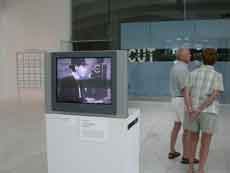
Marclay’s got a second piece in the show, “Telephones” from 1995, and that runs on a monitor in the lobby outside the exhibition gallery. (see image here and below) Like “Quartet” the piece samples and re-mixes sound and images from many movies, this time focused on telephone calls. You can imagine it. It begins with a series of phones ringing, the rings in many different tinkles and tones. There’s a series of people answering, — all your favorite stars in all their best movies saying “Hello” “Hi” “Yah.” There are flare-ups of anger, passages of laughter, some anxious moments and consternation, and the piece ends with a lot of great slam-downs of those telephone receivers. What a movie!
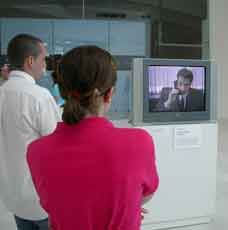
People stopped and stood and watched the 7 and a half minute piece but there was no bench so not a lot of lingering for a second run-through. This piece captures the history of telephones pretty nicely. I’d love to see the artist do an update about cellphones. That would be a very different movie. Not so percussive (nobody slams down a cellphone the way they slam down those old receivers.) And not so static. Pretty much all the phone images in “Telephones” are static, people locked into where the phone is plugged into the wall.
Cellphone conversations in movies generally take place on the hoof. Somebody gets a call while they’re driving the getaway car; somebody takes a call while shopping. The rings are fun and that might be fun to play with, too.

I loved making the acquaintance of the McCoys. Their “Horror Chase” 2002 is a chase sequence lifted from some movie or other and tweaked by a scene randomization program that takes it to a weird other place. The person you see — the victim — comes forward, goes backwards, rounds a corner one way, doubles back another way in a dizzying sort of Cuisinart moviemaking. The thing is mesmerizing. And because of the anxiety level of the victim and the never-ending and always changing chase the piece becomes harrowing and personal. You identify with both the victim and yet seem to be the pursuer as well.
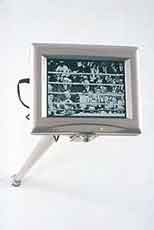
Paul Pfeiffer‘s “The Long Count,” 2001, which erases the boxers in three famous boxing matches and imaginatively adds the audience where the boxers bodies were, is great in theory. I would have liked to see the pieces blown up large. But the installation — on three tiny monitors (the image is 2 1/2″ by 1 1/2″) mounted high on the wall made it hard to spend time with them. I got neck strain from looking up.
I got more out of Pierre Huyghe‘s “L’Eclipse” (1998) (not shown) on this, my second viewing than I did the first time round. Libby and I saw the piece at the 1999/2000 Carnegie International and unfortunately in Pittsburgh the multi-channel work was manfunctioning and several screens were dark. (The piece samples a scene from Wim Wenders‘ 1977 movie “The American Friend” starring Bruno Ganz and pairs it with Huyghe’s footage of Ganz in 1998 walking a path that the original movie implies but does not show)
All the screens were working at MAM and yet the conceptual work — which sounds great on paper — still falls short on viewing. The piece does have some resonance, especially in seeing Ganz, young and full of angst, and then again middle aged and still full of angst. But it’s not breaking news that people (even movie stars) age. So I still think the piece is like an insider’s work — more interesting to a filmmaker than to a casual viewer in an art museum.
Candice Breitz, whose “Soliloquy Trillogy”(2000) ( not shown) distilled blockbuster “star vehicles” down to the star and his/her words made something so annoying I couldn’t stay the course. Jack Nicholson, Clint Eastwood, Sharon Stone — each taken out of context and shown without the softening qualities of a story and other actors to interact with — become scenery chewers I couldn’t wait to escape from. The piece, which, at its heart, bless it, wants to show how horrible the culture of stardom is and how no star is really a star without a lot of help, is, unfortunately, the unkindest cut of all to the actors. I’m a fan of each of them but I couldn’t hack them in this super extreme close up with no relief.
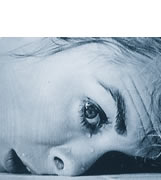
Douglas Gordon‘s “24-Hour Psycho” (1993), a slowing down of Hitchcock’s masterpiece so that each frame is like a still photograph, (the screening takes 24-hours, thus the title) is another work that sounds better on paper than it is in its real-time version. Maybe if you’re a filmmaker yourself and want to study Hitch’s layout and camera-work the piece would teach you something. Here, projected large, the moments snailing by at excruciating lack of speed the piece becomes a curiosity. Now it’s possible that if you saw it when that famous shower scene was on, that you’d really get something new about blood, humanity, fragility of skin, and the beauty/horror of death. But what I saw, which happened to be at the beginning of the film even before Janet Leigh gets to the Bates Motel, had only passing interest.
Michael Joaquin Grey‘s “The Blink” (not shown) takes Leni Riefenstahl‘s “Olympia,” shots of high divers at the 1936 Olympics, and combines it with an audio of Bjork singing a dirge-like reinterpretation of the song “Leaving on a Jet Plane.” The piece, like Pfeiffer’s, is shown in tiny scale, the image doubled and mirrored and placed on a large background of bright red. The installation is in a narrow hallway-like space that makes two viewers feel like a crowd. The installation makes it peepshow-like, although why this affect was needed I am not sure. The installation didn’t work with the subject matter particularly, nor did the scale which would have been more effective if it had been blown up large with the audio just a whisper. But that’s just my edit. That’s all I’ll cover here. The exhibit is on the whole most worthy. Not only does it include some genius works (Marclay) but it raises the issue of appropriation. And the show at its core is about iconoclasm, something we could use a little more of in the world. All these video makers are iconoclasts. They’re out to shatter the gods and give new messages about things like time, class, ownership, and the place of a human being in the larger scheme of things. One thing not touched on in any of the wall text or in the catalog is the length of the final cut which becomes the video art shown in the gallery/museum. With the exception of the Marclays, all the works could have been shortened without damaging their point or their beauty. Video for the most part still demands too much time of the viewer. And museums/galleries don’t take account of that and put enough benches in the viewing space.
(If I get time I’ll put in some more pictures.)
Organized by former MAM Curator Stefano Basilico, “Cut: Film” debuted in Miami last November at the Museum of Contemporary Art (MOCA,) North Miami which assisted MAM in putting the exhibit together. It’s up at MAM to Sept. 11.









